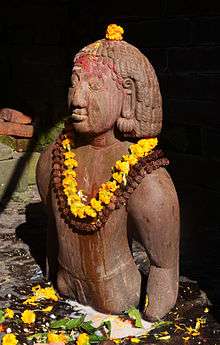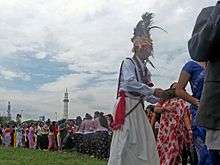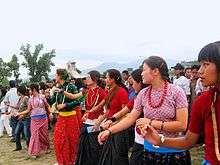Kirant Mundhum

Kirat Mundhum (also Kirati Mundhum), also called Kiratism or Kirantism or simply Mundum, is the religion of the Kirat: Limbu, Rai, Sunuwar and Yakkha peoples of Nepal, India, Myanmar and now practiced in the UK, China, USA and many other countries.[1] The practice is also known as Kirat Veda,[2][3] Kirat-Ko Veda[4] or Kirat Ko Ved.[5] According to some scholars, such as Tom Woodhatch, it is a blend of animism (e.g., ancestor worshiping of Sumnima/Paruhang and Yuma Sammang/Tagera Ningwaphumang),[6] Saivism,[7] and Tibetan Buddhism.[7] It is practiced by about 3.1% of the Nepali population.[8] Before it was recognized as a religion on the Nepali census, 36% of the Kirati population claimed to follow the Kirat religion, but when it was recognized this figure increased to 73.9%, a 157% increase in the Nepali Kiratis.[1]
The Limbu people have their own distinct form of Kirat Mundhum, known as Yuma Sammang or Yumaism; they venerate a supreme goddess called Tagera Ningwaphumang .
In addition to the Ancestral worshiping Kiranti people also worship the Mother Nature, to which some people, especially in the western countries are also commonly known as Earth Worshiping.
Mundhum

Mundhum (also known as Peylan) is the religious scripture and folk literature of the Kirat people of Nepal, central to Kirat Mundhum. All four Kirats (Limbu, Rai, Sunuwar and Yakkha) have slightly different Mundhum. Mundhum means "the power of great strength" in the Kirati language.[9] The Mundhum covers many aspects of the Kirat culture, customs and traditions that existed before Vedic civilisation in South Asia.[10][11][12][13]
The Mundhum for each tribe consists of customs, habits, rituals, traditions, and myths passed down from the Kirati tribe's ancestors. Mundhums serve, in a way, as customary laws which guide Kirats in their daily lives.[14] The Mundhum also distinguishes each Kiranti tribe from other Kirati and non-Kiratis as well.[14]
Practices
Kirats practice shamanism and their rituals are mostly related to the worship of mother nature, ancestors, sun, moon, wind, fire and main pillar of house. Almost all sacred rituals, in Rai, are performed by nakchong, the kirat tribal priest. Similarly Limbus have phɛdɑŋmɑ/bɑ, yɛbɑ/mɑ, sɑmbɑ/mɑ to perform rituals accordingly.
Their supreme deity Tagera Ningwaphuma: tɑgɛrɑ niŋwɑphumɑ is personified as yumɑˀ (not Lord Shiva) according to some scholars.[15]
Many followers wear a tilak on the forehead, as in Hinduism, when they recite their sacred text, the Kiranti Veda i.e. Mundhum[16]
Festivals

All four Kirats celebrate some similar and different festivals throughout the year. Some common festivals are Udhauli, Ubhauli and New year Yele Sambat (Maghe Saktanti).
Sakela is the main festival of Khambu Kirat which is celebrated twice a year distinguished by two names Ubhauli and Udhauli. Sakela Ubhauli is celebrated during Baisakh Purnima (full moon day, which lies in the month of Baisakh in calendars of the Indian Subcontinent.) and Sakela Udhauli is celebrated during the full moon day in the month of Mangh. The Limbu Kirat celebrate udhauli Chasok Tangnam on the day of Mangsir Purnima and Ubhauli (Yokwa Tongnam)in the month of Baisakh. Other Kirats (Yakkha and Sunuwars) also celebrate in their own way. Sakela celebration is the prayer to Goddess of Nature for good crops and protection from natural calamities.
The celebration of Sakela is also known as Chandi Nach Murat. On Chandi Nach, they worship Durga, who is known to them as Chandi, or Chandika.[17] (Worship of Durga among the Himalayan Kiratas is arguably written in the Harivamsha Purana.[18]) Durga Puja is still performed by a few Kirants.[19]
Tihar is another festival that was added first in the Veda. It is also known as Deepavali and Lakshmi Puja.[19]
See also
- Folk Hinduism
- Religion in Nepal
- Buddhism in Nepal
- Hinduism in Nepal
- Demographics of Nepal
- Limbu language
References
- 1 2 final layout pdf.p65
- ↑ p. 56 Kiratese at a Glance By Gopal Man Tandukar
- ↑ p. xxv A Grammar of Limbu By George van Driem
- ↑ Problems of Modern Indian Literature by Statistical Pub. Society: distributor, K. P. Bagchi
- ↑ p. 323 Kiratas in Ancient India By G. P. Singh, Dhaneswar Kalita, V Sudarsen, M A Kalam
- ↑ "History and Culture of the Kirat" by I.S.Chemjong
- 1 2 p. 535 Nepal By Tom Woodhatch
- ↑ http://cbs.gov.np/wp-content/uploads/2012/11/National%20Report.pdf
- ↑ Hardman, Charlotte E. (December 2000). John Gledhill; Barbara Bender; Bruce Kapferer (eds.), eds. Other Worlds: Notions of Self and Emotion among the Lohorung Rai. Berg Publishers. pp. 104–. ISBN 978-1-85973-150-5.
- ↑ Dor Bahadur Bista (1991). Fatalism and Development: Nepal's Struggle for Modernization. Orient Longman. pp. 15–17. ISBN 81-250-0188-3.
- ↑ Cemjoṅga, Īmāna Siṃha (2003). History and Culture of the Kirat People. Kirat Yakthung Chumlung. pp. 2–7. ISBN 99933-809-1-1.
- ↑ Cultures & people of Darjeeling
- ↑ Gurung, Harka B. (2003). Trident and Thunderbolt: Cultural Dynamics in Nepalese Politics (PDF). Nepal: Social Science Baha. ISBN 99933-43-44-7. OCLC 57068666.
- 1 2 p. 65 Culture, Creation, and Procreation By Monika Böck, Aparna Rao
- ↑ p. 107 Politics of Culture:A study of three Kirata communities in the Eastern Himalayas by T.B. Subba
- ↑ p. 282 Patrika: Newsletter of the Indian Academy of Sciences By Vivekananda Kendra, Indian Academy of Sciences
- ↑ p. 76 Kiratas in Ancient India By G. P. Singh, Dhaneswar Kalita, V Sudarsen, M A Kalam
- ↑ p. 195 Ancient Communities of the Himalaya By Dinesh Prasad Saklani
- 1 2 p. 108 Politics of Culture:A study of three Kirata communities in the Eastern Himalayas by T.B. Subba